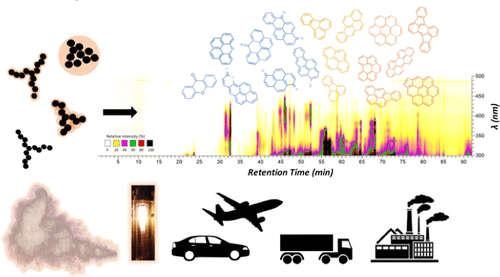当前位置:
X-MOL 学术
›
ACS Earth Space Chem.
›
论文详情
Our official English website, www.x-mol.net, welcomes your feedback! (Note: you will need to create a separate account there.)
Molecular Composition and the Optical Properties of Brown Carbon Generated by the Ethane Flame
ACS Earth and Space Chemistry ( IF 3.4 ) Pub Date : 2020-06-19 , DOI: 10.1021/acsearthspacechem.0c00095 Christopher P. West 1 , Anusha Priyadarshani Silva Hettiyadura 1 , Andrew Darmody 1 , Gaurav Mahamuni 2 , Justin Davis 3 , Igor Novosselov 2 , Alexander Laskin 1
ACS Earth and Space Chemistry ( IF 3.4 ) Pub Date : 2020-06-19 , DOI: 10.1021/acsearthspacechem.0c00095 Christopher P. West 1 , Anusha Priyadarshani Silva Hettiyadura 1 , Andrew Darmody 1 , Gaurav Mahamuni 2 , Justin Davis 3 , Igor Novosselov 2 , Alexander Laskin 1
Affiliation

|
Atmospheric “Brown Carbon” (BrC) is a complex mixture of organic compounds with diverse composition and variability of its light-absorbing properties. BrC formed by incomplete combustion of fossil fuels and biomass has been shown to be an important contributor to the light absorption by atmospheric aerosols. Previous reports provided substantial molecular information of BrC related to biomass burning emissions; however, very few studies describe BrC generated from hydrocarbon fuel combustion. The work presented here is the first study that identifies and characterizes BrC formed in the controlled flame combustion of ethane, one of the most basic hydrocarbon fuels. To understand the molecular composition and optical properties of BrC, we used an analytical platform that includes high-performance liquid chromatography (HPLC) coupled to photodiode array (PDA) detection, followed by dopant-assisted atmospheric pressure photoionization (APPI) and high-resolution mass spectrometry (HRMS). For this study, six soot samples were generated in a custom-built inverted gravity flame reactor (IGFR) at different combustion settings. The temperature of the diffusion flame was controlled by fuel dilution with argon (up to 80% v/v) and was measured to be in the range of 1750–1950 K. Basic characterization of the samples (i.e., mass loading, OC/soot ratio) was employed, followed by molecular speciation of BrC chromophores. A vast majority of BrC chromophores identified in these samples are oxygenated polycyclic aromatic hydrocarbons (O-PAHs) and unsubstituted PAHs. Nearly 90% of the total BrC absorbance was attributed to approximately equal contributions from the groups of: O-PAHs, low- and high-molecular-weight PAHs referred as PAH < BaP and PAH > BaP (i.e., smaller and larger than Benzo[a]pyrene (BaP), respectively). The mass absorption coefficient (MACbulk) measured at λ350 nm for the BrC fraction of aerosol emitted from the hottest undiluted flame (Tmax = 1946 K) was 0.49 m2 g–1, while 0.004 m2 g–1 was measured for aerosol emitted from the colder flame (Tmax = 1863 K, 67% dilution). The optical properties of BrC generated in the hottest flame are comparable to previous measurements of BrC generated from gasoline combustion of motor vehicles.
中文翻译:

乙烷火焰产生的褐碳的分子组成和光学性质
大气中的“布朗碳”(BrC)是有机化合物的复杂混合物,其组成和吸光性各不相同。由化石燃料和生物质的不完全燃烧形成的BrC已被证明是大气气溶胶吸收光的重要因素。先前的报告提供了与生物质燃烧排放有关的BrC的大量分子信息;但是,很少有研究描述碳氢化合物燃料燃烧产生的溴化碳。此处介绍的工作是首次鉴定和表征在乙烷(一种最基本的烃类燃料)的受控火焰燃烧中形成的BrC的第一项研究。要了解BrC的分子组成和光学性质,我们使用的分析平台包括高效液相色谱(HPLC)和光电二极管阵列(PDA)检测,然后是掺杂剂辅助的大气压光电离(APPI)和高分辨率质谱(HRMS)。对于本研究,在定制的倒置重力火焰反应器(IGFR)中以不同的燃烧设置生成了六个烟灰样品。扩散火焰的温度通过用氩气稀释燃料(最高80%v / v)来控制,测得的温度范围为1750–1950K。样品的基本表征(即,质量负载,OC /烟灰)比例),然后对BrC发色团进行分子形态分析。这些样品中鉴定出的绝大多数BrC生色团是氧化的多环芳烃(O-PAH)和未取代的PAH。分别是] py(BaP)。从最热的未稀释火焰(T max = 1946 K)发出的气溶胶的BrC分数在λ350 nm处测得的质量吸收系数(MAC bulk)为0.49 m 2 g –1,而对于0.004 m 2 g –1测得较冷的火焰散发出的气溶胶(T max = 1863 K,稀释度为67%)。在最热的火焰中生成的BrC的光学特性与先前由机动车辆的汽油燃烧生成的BrC的测量结果相当。
更新日期:2020-07-16
中文翻译:

乙烷火焰产生的褐碳的分子组成和光学性质
大气中的“布朗碳”(BrC)是有机化合物的复杂混合物,其组成和吸光性各不相同。由化石燃料和生物质的不完全燃烧形成的BrC已被证明是大气气溶胶吸收光的重要因素。先前的报告提供了与生物质燃烧排放有关的BrC的大量分子信息;但是,很少有研究描述碳氢化合物燃料燃烧产生的溴化碳。此处介绍的工作是首次鉴定和表征在乙烷(一种最基本的烃类燃料)的受控火焰燃烧中形成的BrC的第一项研究。要了解BrC的分子组成和光学性质,我们使用的分析平台包括高效液相色谱(HPLC)和光电二极管阵列(PDA)检测,然后是掺杂剂辅助的大气压光电离(APPI)和高分辨率质谱(HRMS)。对于本研究,在定制的倒置重力火焰反应器(IGFR)中以不同的燃烧设置生成了六个烟灰样品。扩散火焰的温度通过用氩气稀释燃料(最高80%v / v)来控制,测得的温度范围为1750–1950K。样品的基本表征(即,质量负载,OC /烟灰)比例),然后对BrC发色团进行分子形态分析。这些样品中鉴定出的绝大多数BrC生色团是氧化的多环芳烃(O-PAH)和未取代的PAH。分别是] py(BaP)。从最热的未稀释火焰(T max = 1946 K)发出的气溶胶的BrC分数在λ350 nm处测得的质量吸收系数(MAC bulk)为0.49 m 2 g –1,而对于0.004 m 2 g –1测得较冷的火焰散发出的气溶胶(T max = 1863 K,稀释度为67%)。在最热的火焰中生成的BrC的光学特性与先前由机动车辆的汽油燃烧生成的BrC的测量结果相当。



























 京公网安备 11010802027423号
京公网安备 11010802027423号